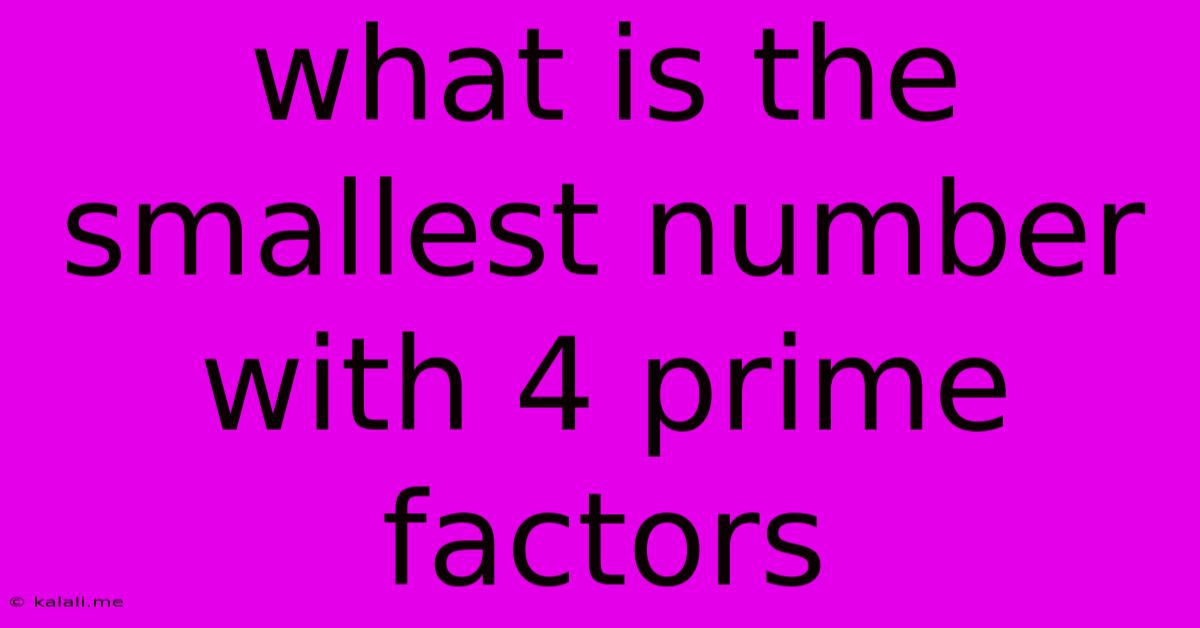What Is The Smallest Number With 4 Prime Factors
Kalali
May 22, 2025 · 2 min read

Table of Contents
What is the Smallest Number with 4 Prime Factors?
Finding the smallest number with four prime factors requires understanding prime numbers and factorization. This article will explore this mathematical concept, explaining the process and revealing the answer. We'll also delve into some related concepts to enhance your understanding of prime factorization.
The smallest number with four prime factors is a fascinating problem that combines number theory and computational thinking. Understanding how to approach this question provides a valuable insight into the fundamentals of mathematics.
Understanding Prime Numbers and Prime Factorization
Before diving into the problem, let's refresh our understanding of key terms:
-
Prime Number: A prime number is a natural number greater than 1 that has no positive divisors other than 1 and itself. Examples include 2, 3, 5, 7, 11, and so on.
-
Prime Factorization: Prime factorization (or integer factorization) is the process of finding the prime numbers which multiply together to give the original number. This process is unique for every number. For example, the prime factorization of 12 is 2 x 2 x 3 (or 2² x 3).
Finding the Smallest Number
To find the smallest number with four prime factors, we need to select the four smallest prime numbers and multiply them together. These are 2, 3, 5, and 7.
Therefore, the smallest number with four prime factors is:
2 x 3 x 5 x 7 = 210
This number has only four prime factors: 2, 3, 5, and 7, and no smaller number satisfies this condition. Any other combination of four prime numbers will result in a larger product. For instance, using primes like 2, 2, 2, 3 results in 24, but this only has three unique prime factors. Similarly, using larger prime numbers would naturally yield a larger product.
Expanding the Concept: Exploring Variations
While we've found the smallest number with four distinct prime factors, we can also consider scenarios with repeated prime factors. For example:
- Smallest number with four prime factors (allowing repetition): This would be 2 x 2 x 2 x 2 = 16, which has four prime factors, all of which are 2. However, this isn't generally considered the answer to the question unless specifically stated.
The focus is typically on distinct prime factors, as this provides a more unique and challenging mathematical problem.
Conclusion: The Significance of Prime Factorization
Understanding prime factorization is fundamental in many areas of mathematics and computer science. It's crucial for cryptography, particularly in RSA encryption, where the security relies on the difficulty of factoring large numbers into their prime components. The seemingly simple problem of finding the smallest number with four prime factors offers a gateway to appreciating the power and elegance of prime numbers and their factorization. The solution, 210, while straightforward to calculate, highlights the foundational principles of number theory.
Latest Posts
Latest Posts
-
How To Add Addresses To Google Maps
May 22, 2025
-
How To Sync Wii Balance Board
May 22, 2025
-
Three Sheets To The Wind Etymology
May 22, 2025
-
The Pen Is Mightier Than The Sword Who Said
May 22, 2025
-
Duty Free Paris Charles De Gaulle
May 22, 2025
Related Post
Thank you for visiting our website which covers about What Is The Smallest Number With 4 Prime Factors . We hope the information provided has been useful to you. Feel free to contact us if you have any questions or need further assistance. See you next time and don't miss to bookmark.